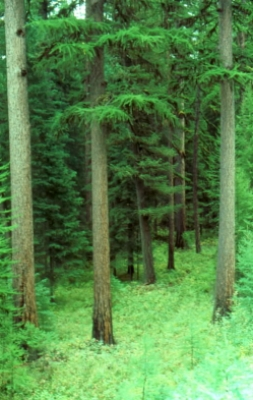A Deciduous Conifer, the Western Larch has a Contrary Nature
by Andy Kerr
The line drawing was scanned from a US Forest Service publication that I have long forgotten, so to which I cannot give credit. As a product of the federal government, it is in the public domain.Not all conifers are evergreens. The ten species of larch (Larix spp.), located mostly in the colder climates in the northern Hemisphere, are conifers (they have cones), but also lose their needles each fall. Three larch species are found in North America: the alpine larch found primarily at high elevations in western Canada; the eastern larch found in boggy areas of the northern forests of eastern North America; and the western larch found in the American West. Commonly called tamarack in the east, this name is sometimes used out West, too. The only other North American "deciduous conifer" is the bald cypress (Taxodium districhum), found in the American southeast.
Each autumn, the western larch sheds its needles. Oregon's larch is the western larch (Larix occidentalis). This tallest larch species can reach 150 feet in height, four feet in diameter at the base and 500 years of age. Some specimens reach 200 feet, six feet at the base and live up to 1,000 years. Their great height often makes them an easy target for lightning.
The western larch is easily identified at a distance. During the spring and summer, the bright, almost iridescent, green color of the needles sets it apart from the duller green of the forest's other conifers. Starting in October, the needles turn yellow; by the end of the month they are a brilliant yellow-gold. During the winter, the trees remain distinctive, standing tall and straight without needles.
From a distance, the branches often look feathery, in that the branches are covered with a uniform row of light-green needle clumps. In hand, the needles are very soft and are one to two inches long. There are 14 or more needles per bud. The western larch's small cones are woody and brown.
The bark at the tree's base is quite thick, up to six inches in an old-growth specimen. The bark is a furled reddish orange and jigsaw-shaped somewhat like that of ponderosa pine. The thickness of the bark, and the fact that the first limbs often begin up to 50 feet from the ground on a large tree, make the western larch the most fire resistant tree in the Pacific Northwest.

Mature Western Larch Forest. Occasionally fire does win the battle with the larch. The dying larch responds by producing huge numbers of seeds that can be dispersed — by the wind — up to 400 feet away. The large-winged seeds are very small; it takes about 143,000 seeds to make a pound. After a fire, western larch often re-establishes itself at the same rate as lodgepole pine, another fast-growing species. As the canopy closes, western larch is eventually replaced by other, more shade-tolerant species in the stand until fire again gives the fire-tolerant larch the advantage.
In Oregon, larch can be found between 3,000 and 7,000 feet in elevation along the east side of the Cascade Range south to the Metolius watershed, but are most abundant in the mountain ranges of the Blue Mountains Ecoregion (Ochoco, Strawberry, Aldrich, Greenhorn, Elkhorn, Wallowa and Blues). Outside Oregon, the western larch ranges through southeastern British Columbia, southwestern Alberta, central and eastern Washington, northern Idaho and western Montana. It prefers the generally moist locations of north slopes and valley bottoms.
The utility of the western larch is not limited to its beauty. Rotting cavities within large trucks provide homes to several songbird species, woodpeckers, owls and flying squirrels. Occasionally osprey, bald eagle and even Canada geese make their large platform nests in western larch trees. Both blue and spruce grouse eat the buds and leaves. Black bear favor larch trees for escape because the textured bark and large size make for easy climbing (if one is a bear).
Glactan, the natural sugar gum in the wood, resembles a slightly bitter honey and can be made into baking powder (in case you're running low and can't get to the store).
The native quinine conk (Fomes officinalis) that grows perpendicular on tree trunks can be deadly to western larch, but has medicinal value to humans. In earlier times, conk grown high above the forest floor was harvested by rifle shot and sold to European pharmaceutical firms.
In the autumn, the golden larch stand out from other conifer species that don't lose their needles. The larch casebearer (Coleophora laricella), a native of Europe, was introduced to the range of the western larch and is now a serious pest that defoliates victim trees. In Europe, the casebearer is naturally controlled by parasites, as it is in eastern North America. But importing the parasites to the West has not been effective as a control measure. Fortunately, the western larch is accustomed to losing its needles and will grow a second crop if defoliated in the spring. However, repeated defoliation stresses the trees and does not bode well for the larch's ability to compete in the forest environment of the future.
Arno, Stephen F. and Ramona P. Hammerly. 1997. Northwest Trees: Identifying and Understanding the Region's Native Trees. Seattle: The Mountaineers Books. 41-45.
Jensen, Edward C. and Charles R. Ross. 1995. Trees to Know in Oregon. Corvallis: Oregon State University Extension Service and Oregon Department of Forestry. 26-27.
Reprinted from Oregon Wild: Endangered Forest Wilderness.
Photos by George Weurthner.


